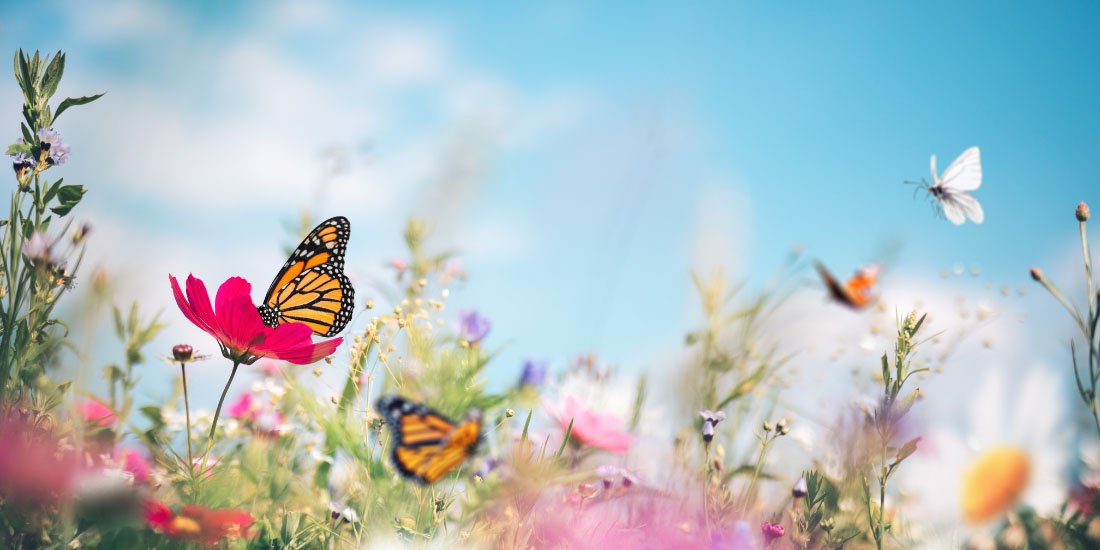It’s time to sow wildflowers

The Essence of UK Wildflowers:
British wildflowers are more than just a visual spectacle – they are a vital thread in the intricate web of nature. From the delicate bluebells that carpet our woodlands to the striking poppies that grace our fields, these native plants have adapted over centuries to thrive in their unique habitats. They offer nectar and pollen for pollinators like bees and butterflies, helping to sustain crucial populations and promote biodiversity. While the addition of meadow grasses provides a natural wonderland for smaller creatures (like hedgehogs) to take shelter, develop families, and create communities.
Benefits of Sowing UK Wildflower seeds:
Supporting Pollinators
The decline of pollinators is a pressing concern worldwide. But, by cultivating a pollinator-friendly garden with local wildflowers, we can provide essential food sources for bees, butterflies, and other pollinators, contributing to the health of our local ecosystems and helping support the beauty of our planet.
Low Maintenance Landscaping
Creating a wildflower meadow adds beauty to your garden and is relatively low-maintenance. Once established, it requires less water and mowing than traditional lawns, making them an eco-friendly landscaping choice.
Preserving Indigenous Heritage
Many of these wildflowers hold cultural significance and have been a part of British heritage for generations. By sowing and nurturing UK wildflowers, we help preserve these connections to our past and keep wild Britain thriving all around us!
Strengthening Local Ecosystems
They contribute to the intricate balance of local ecosystems and help keep our islands alive with their pleasant smells, vibrant colours and the diversity of wildlife they support.
Sowing Wildflowers: A Step-by-Step Guide:
Selecting the Right Seeds
Choose native wildflower seeds well-suited to your garden’s soil type and one that provides the range of wildflowers you want to see in your garden. Consider a mix of species to create a diverse and visually appealing meadow – and we have created a range of wildflower seed mixes to ensure there’s something to suit every garden.
We have wildflower-only seed mixes, some that contain only annuals for a vibrant pop of colour that lasts one season, and a blend of UK Native annuals and perennial wildflowers that return year after year to garnish your garden with a flora-full meadow. We also have mixes that feature annuals and perennials combined with meadow grasses to provide a protective habitat for local wildlife.
Knowing when to sow wildflowers
The ideal time to sow wildflower seed spans from March to October, leading to wildflowers blossoming around 60-80 days after sowing. If planted in the early spring months (March/April), the annuals in your blend will grace your summer with their presence. On the other hand, sowing during the early autumn (September/October) will see them emerge in the following spring.
We recommend sowing your seeds during early autumn to enjoy a vibrant display of wildflowers when spring arrives to achieve the best growth and the speediest results.
Planting wildflower seeds
Once you’ve picked your seed and decided when to sow, it’s time to get the seedbed ready for sowing wildflowers. When planting any wildflower seed mix, we recommend removing any existing grass, weeds or flora from the planting area before doing anything else, as this will prevent any other seeds from establishing amongst your wildflower seeds and making life harder for them!
- Wildflowers prefer harsher soil conditions, so you need to reduce the soil fertility, and this can be achieved by removing the top 5-10cm layer.
- Allow the area to undergo cultivation for a few weeks, ensuring the removal of any emerging weeds.
- Avoid adding topsoil, compost, or fertilisers to the seedbed, as wildflowers thrive in low-nutrient environments.
- Following the cultivation period, remove stones and debris and use a rake to create a fine textured, crumbly, and levelled-out seedbed.
- Now it’s time to sow your wildflower seed by evenly scattering your seeds at a rate of 5g per square meter.
- Then gently rake the seed into the soil to ensure even distribution.
- Thoroughly water the freshly sown wildflower seed.
- In dry conditions, provide sufficient watering to maintain moisture in the area for six weeks after sowing.
Watering and Care
Keep the area consistently moist until the seeds germinate and establish themselves. Once they’re established, wildflowers generally require less water than traditional garden plants and will look after themselves as long as there is some rainfall every now and again. Water your wildflowers daily during hot and dry periods to stop them from drying out and wilting, especially if there’s a heatwave.
Enjoying the Results
As the wildflowers grow and bloom, take time to marvel at the natural beauty you’ve helped create. The presence of wildflowers in your garden will encourage others to appreciate the splendour of British wildflowers and the vital role they play in our environment.
Autumn is a great time to sow British wildflowers
As we bid farewell to summer and anticipate the changing seasons, let’s take a moment to celebrate the enchanting world of British wildflowers. By sowing the seeds of these remarkable plants, we beautify our landscapes with their stunning looks and contribute to the well-being of our environment. Take the opportunity to add UK wildflower seeds to your garden and witness the transformation of your surroundings into a haven of biodiversity and colour. Now is the time to sow wildflower seeds, so let’s come together to paint the UK with the vibrant hues of its native wildflowers!
We have a detailed guide on the difference between annual and perennial wildflowers for further reading.
Our Wildflower Help & Advice area is filled with helpful tips for growing wildflowers.
And our Wildflower Frequently Asked Questions section features a wealth of answers to questions commonly asked by our customers. Please message us if you have any questions about anything discussed above, and we will be happy to help.